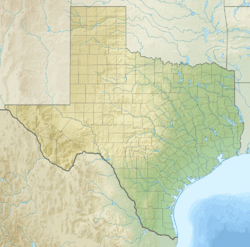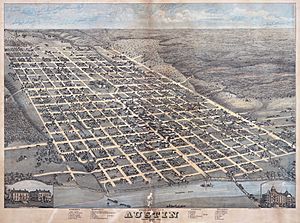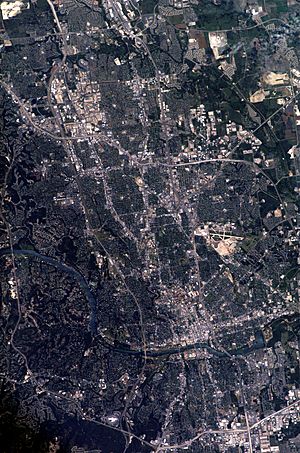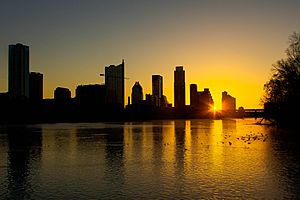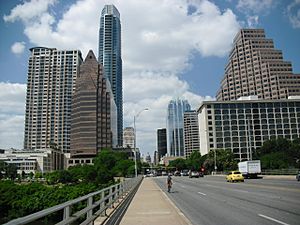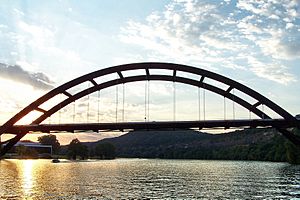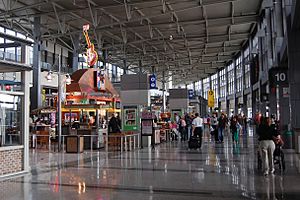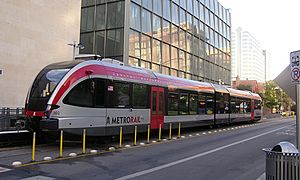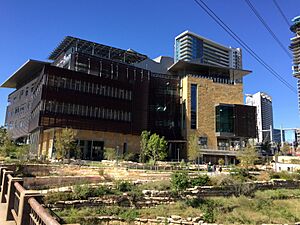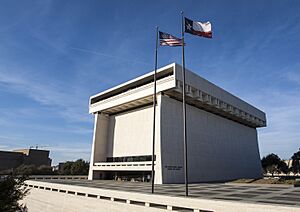Austin, Texas facts for kids
Quick facts for kids
Austin
|
|||||
|---|---|---|---|---|---|
|
Downtown Austin skyline
Congress Avenue Bridge
Darrell K Royal–Texas Memorial Stadium
Main Building at the University of Texas at Austin
Paramount Theatre
|
|||||
|
|||||
| Nicknames:
Live Music Capital of the World, Silicon Hills, ATX, City of the Violet Crown
|
|||||
| Motto(s):
Keep Austin Weird (unofficial)
|
|||||
| Country | |||||
| State | |||||
| Counties | Travis, Hays, Williamson | ||||
| Settled | 1835 | ||||
| Incorporated | December 27, 1839 | ||||
| Named for | Stephen F. Austin | ||||
| Government | |||||
| • Type | Council–manager | ||||
| Area | |||||
| • State capital | 326.51 sq mi (845.66 km2) | ||||
| • Land | 319.94 sq mi (828.64 km2) | ||||
| • Water | 6.57 sq mi (17.02 km2) | ||||
| • Metro | 4,285.70 sq mi (11,099.91 km2) | ||||
| Elevation | 607 ft (185 m) | ||||
| Population
(2022)U.S. Census Estimates
|
|||||
| • State capital | 974,447 |
||||
| • Rank | 33rd in North America 11th in the United States 4th in Texas |
||||
| • Density | 3,006.36/sq mi (1,160.76/km2) | ||||
| • Urban | 1,809,888 (US: 29th) | ||||
| • Urban density | 2,921.0/sq mi (1,127.8/km2) | ||||
| • Metro | 2,473,275 (US: 26th) | ||||
| Demonym(s) | Austinite | ||||
| GDP | |||||
| • Metro | 2.054 billion (2022) | ||||
| Time zone | UTC−6 (CST) | ||||
| • Summer (DST) | UTC−5 (CDT) | ||||
| ZIP Codes |
73301, 73344, 78681, 78701–78705, 78708–78739, 78741–78742, 78744–78768, 78772–78774, 78778–78779, 78783, 78799
|
||||
| Area codes | 512 & 737 | ||||
| FIPS code | 48-05000 | ||||
| GNIS feature ID | 2409761 | ||||
Austin is the capital city of Texas, a state in the United States. It is also the main city in Travis County. Some parts of Austin reach into Hays and Williamson counties.
Austin became a city on December 27, 1839. It is one of the largest cities in the U.S. and the fourth biggest in Texas. Only Houston, San Antonio, Dallas, and Fort Worth are larger. Austin is also the second-largest state capital in the U.S., after Phoenix. Since 2010, Austin has been one of the fastest-growing big cities in the country.
As of 2024, Austin has about 984,567 people. The city is a major center for culture and business in the Austin–Round Rock area. This larger area has about 2.4 million people. Austin is in Central Texas, in a beautiful area called the Texas Hill Country. It has many lakes, rivers, and waterways, like Lady Bird Lake and Lake Travis on the Colorado River.
People who live in Austin are called Austinites. They include many different kinds of people, like government workers, college students, musicians, and tech workers. Austin's official slogan is "The Live Music Capital of the World." This is because of its many musicians and places to hear live music. The famous TV show Austin City Limits is also filmed here.
Austin is also known for South by Southwest (SXSW). This is a huge yearly event that brings together film, interactive media, and music festivals. In the 1990s, Austin got the nickname "Silicon Hills" because many technology companies moved here. A popular unofficial slogan is "Keep Austin Weird." This idea encourages people to support small, unique local businesses. Austin is also called the "City of the Violet Crown" because of the colorful sunsets over the hills.
Austin used to focus mostly on government and education. But since the 1990s, it has become a big center for technology and business. Many large companies, like Apple, Amazon, Google, IBM, and Tesla, have offices or headquarters in Austin. The University of Texas at Austin is also located here. It is one of the biggest universities in the U.S. with over 50,000 students. In 2021, Austin got its first major professional sports team, Austin FC, a soccer team.
Contents
Austin's Past: A Look at History
Austin and the areas around it have been home to people for a very long time, since at least 9200 BC. The first known people lived here during the Ice Age.
When settlers from Europe arrived, the Tonkawa tribe lived in the area. The Comanche and Lipan Apache tribes also traveled through. Spanish explorers came through for centuries, but they didn't build many lasting towns. In 1730, a Spanish mission was set up near what is now Zilker Park in Austin.
In the early 1800s, new towns started in Central Texas. But growth was slow because of fights with Native American tribes.
Becoming the Capital City
In 1835–1836, Texans fought for and won their independence from Mexico. Texas became its own country. In 1839, the Texas Congress looked for a new capital city. Vice President Mirabeau B. Lamar suggested a place called Waterloo, near the Colorado River. He liked its hills and waterways. Waterloo was chosen and renamed Austin after Stephen F. Austin, who helped settle Texas.
Edwin Waller designed the new capital. He planned a 14-block grid with a wide street, Congress Avenue, running from the river to where the Texas State Capitol would be built. The first land sales happened on August 1, 1839. This grid plan is still the basis for downtown Austin today.
In 1840, battles between the Texas Rangers and the Comanches pushed the Comanches westward. This helped the area grow quickly. Travis County was created in 1840.
Growth and Challenges
At first, the new capital did very well. But then, the government temporarily moved away. This caused Austin's population to drop. However, in 1845, the government decided to keep Austin as the capital. Texas then joined the United States.
In 1861, during the American Civil War, Austin residents voted against leaving the U.S. But as the war went on, many men from Austin joined the Confederate army. After the war, many formerly enslaved African Americans moved to Austin. They created new communities like Wheatville and Clarksville. Clarksville is the oldest surviving "freedomtown" west of the Mississippi River.
The city grew a lot after the war. In 1871, the Houston and Texas Central Railway opened, making Austin a major trading center. Farmers could now easily send cotton and cattle to other places.
In the 1880s, Austin became even more important when the state capitol building was finished in 1888. It was one of the largest buildings in the world at the time. Austin also built its first dam on the Colorado River to power a new streetcar line and special "moon towers" that lit up the city at night.
Modern Austin Takes Shape
In the 1920s and 1930s, Austin started many projects to build up the city. They created new roads, parks, and dams along the Colorado River. These dams formed the Texas Highland Lakes, which help control floods and provide places for fun activities like boating.
During the early 1900s, different groups of people in Austin often lived in separate areas. Many city projects were designed around this separation.
After the mid-1900s, Austin became a major city in Texas. In the late 20th century, it became a big center for technology, especially for computer chips and software. The University of Texas at Austin also grew into a very important university.
The 1970s brought Austin to the national music scene. Artists like Willie Nelson became famous. Music venues like the Armadillo World Headquarters opened. The TV show Austin City Limits and the South by Southwest music festival helped make Austin known for its music around the world.
Austin's Geography and Landscape
Austin is the southernmost capital city in the United States. It is located in Central Texas, about 150 miles northwest of Houston. It is also 160 miles south of Dallas and 75 miles north of San Antonio. The city's height above sea level ranges from 425 feet to about 1,000 feet.
Austin sits on the Colorado River. There are three man-made lakes within the city: Lady Bird Lake, Lake Austin, and Lake Walter E. Long. These lakes are great for boating, swimming, and other fun activities. The western part of Austin has rolling hills, while the eastern part is flatter.
Austin is a green city with many different kinds of plants and animals. It is famous for its wildflowers, especially the bluebonnets, which bloom beautifully in the spring.
A popular spot in Austin is Mount Bonnell. It's a natural limestone hill about 780 feet above sea level. From its observation deck, you can see amazing views of Lake Austin and the Colorado River.
Austin also has several places for rock climbing. You can find climbing routes at Barton Creek Greenbelt, Bull Creek Park, and McKinney Falls State Park.
City Views and Downtown Austin
Austin's skyline has changed a lot since 2000. Many tall buildings have been built. The city's tallest building, The Austonian, was finished in 2009. There are rules that keep some views of the Texas State Capitol clear from different parts of the city.
At night, parts of Austin are lit by "artificial moonlight" from special Moonlight Towers. These 165-foot tall towers were built in the late 1800s. Only 15 of the original 31 towers are still standing in Austin. They are now historic landmarks and were even featured in the 1993 movie Dazed and Confused.
Downtown Area
Downtown Austin has some of the tallest condo towers in Texas. The Independent, a very tall residential building, is being built there.
Downtown has grown a lot, with many people choosing to live there. This growth is helped by the lively music and nightlife, museums, restaurants, and Lady Bird Lake. The 2nd Street District has new homes, restaurants, shops, and Austin's City Hall. The Austin City Limits TV show is filmed at the ACL Live @ the Moody Theatre downtown. The South by Southwest festival also takes over downtown every March.
Austin's Climate
Austin has a humid subtropical climate. This means it has very long, hot summers. Spring and fall are warm, and winters are short and mild. Austin gets about 34 inches of rain each year, spread out evenly. There's also lots of sunshine, almost 2,650 hours a year.
Summers in Austin are very hot. In July and August, temperatures often reach the mid-90s °F (34–36 °C). Temperatures can even go over 100 °F (38 °C) about 18 days a year. The hottest temperature ever recorded was 112 °F (44 °C).
Winters are mild. In December and January, daytime temperatures average around 62–63 °F (17 °C). It only freezes about 19 nights a year. Snow is very rare in Austin.
People and Diversity in Austin
| Historical population | |||
|---|---|---|---|
| Census | Pop. | %± | |
| 1850 | 629 | — | |
| 1860 | 3,494 | 455.5% | |
| 1870 | 4,428 | 26.7% | |
| 1880 | 11,013 | 148.7% | |
| 1890 | 14,575 | 32.3% | |
| 1900 | 22,258 | 52.7% | |
| 1910 | 29,860 | 34.2% | |
| 1920 | 34,876 | 16.8% | |
| 1930 | 53,120 | 52.3% | |
| 1940 | 87,930 | 65.5% | |
| 1950 | 132,459 | 50.6% | |
| 1960 | 186,545 | 40.8% | |
| 1970 | 253,539 | 35.9% | |
| 1980 | 345,890 | 36.4% | |
| 1990 | 465,622 | 34.6% | |
| 2000 | 656,562 | 41.0% | |
| 2010 | 790,390 | 20.4% | |
| 2020 | 961,855 | 21.7% | |
| 2023 (est.) | 979,882 | 24.0% | |
| U.S. Decennial Census 2010–2020 |
|||
In 2020, Austin had 961,855 people. The city has grown a lot since 2000.
Austin is a very diverse city. In 2020, about 48.3% of people were non-Hispanic white. About 33.9% were Hispanic or Latino. About 7.8% were African American, and 7.6% were Asian. The city's Hispanic and Asian populations have grown very quickly.
Most people in Austin are Christians, with many being Catholic. There are also people who follow Islam, Buddhism, Sikhism, Hinduism, and Judaism. Austin also has a strong community of people who are not religious.
Austin's Economy and Jobs
Austin is a major center for high tech companies. Many students from the University of Texas at Austin's engineering and computer science programs find jobs in Austin's tech and defense industries. Because of all the tech companies, Austin is sometimes called "Silicon Hills."
Some of the biggest employers in Austin include the Austin Independent School District, the City of Austin, Dell Technologies, the U.S. Government, IBM, and the University of Texas at Austin.
Many other well-known tech companies have offices in Austin, such as 3M, Apple, Amazon, AMD, Google, Intel Corporation, Meta (Facebook), Oracle, and Samsung Group.
Tesla, Inc., which makes electric vehicles, has its main office in Austin at Gigafactory Texas. This factory employs over 20,000 people.
Austin is also becoming a hub for companies that make medicines and work in biotechnology. The city has about 85 of these companies.
Whole Foods Market, a large grocery store chain, started in Austin and has its headquarters here.
Getting Around Austin
Most people in Austin drive alone to work or school. However, many also carpool, use public transportation, walk, or bike.
Roads and Highways
Central Austin is located between two main north-south highways: I-35 to the east and the Mopac Expressway (Loop 1) to the west. US 183 runs northwest to southeast, and SH 71 goes east to west across the southern part of the city. Austin is the largest U.S. city with only one Interstate Highway.
The Loop 360 is a beautiful highway that goes through the hill country. The famous Pennybacker Bridge, also known as the "360 Bridge," crosses Lake Austin on this loop.
Toll Roads
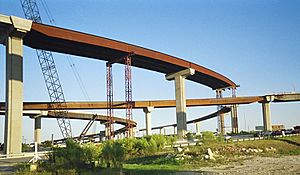
SH 130 is a toll road that helps ease traffic on I-35. It runs east of Austin. Part of SH 130 has a speed limit of 85 mph, which is one of the highest in the United States. Other toll roads like SH 45 and 183A Toll Road also help people get around faster.
Airports
Austin's main airport is Austin–Bergstrom International Airport (ABIA). It is about 5 miles southeast of the city. It used to be a military air force base.
Trains and Buses
Amtrak's Texas Eagle train stops in Austin. It travels between Chicago and San Antonio, and sometimes goes all the way to Los Angeles.
Greyhound Lines and other bus companies offer long-distance bus service from Austin to other cities in the U.S. and Mexico.
Public Transportation
CapMetro provides public transportation in Austin. They have local buses, express buses, and a bus rapid transit service called CapMetro Rapid. In 2010, CapMetro opened a 32-mile hybrid rail system called CapMetro Rail. This train connects downtown Austin with other neighborhoods and the suburb of Leander.
In 2020, voters approved a big plan called Project Connect. This plan will add new light rail lines, more bus rapid transit, and other ways to improve public transport in Austin.
Biking and Walking
Bicycles are a popular way to get around, especially for students at the University of Texas. Austin has a bike-sharing service called CapMetro Bike. You can rent bikes from stations around downtown. There are also rentable electric scooters available.
Austin has removed rules that required new buildings to have a certain number of parking spaces. This is to encourage more walking, biking, and public transit.
Austin's Culture and Fun Things to Do
The saying "Keep Austin Weird" is a popular local motto. It's on bumper stickers and T-shirts. This saying encourages people to support local, unique businesses and keep Austin's special personality. It also shows how much Austinites care about protecting the environment and local culture.
Austin is a very connected city. People in Austin read and write blogs more than in any other U.S. city. They also use the internet a lot.
South Congress is a popular shopping area with coffee shops, unique stores, restaurants, and food trucks. It's known for keeping Austin weird. The Rainey Street Historic District used to be a quiet neighborhood but is now a lively area with bars and restaurants in old bungalow homes.
Austin is part of the UNESCO Creative Cities Network for its media arts.
"Old Austin" Vibe
"Old Austin" is a phrase used by people who have lived in Austin for a long time. It refers to a time when the city was smaller, more artistic, and less expensive. It had less traffic and fewer big chain stores. Many long-time residents miss this "Old Austin" feeling as the city grows and changes quickly.
Yearly Events and Festivals
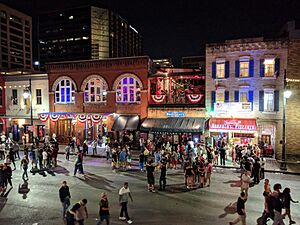
Austin hosts many fun events each year. The O. Henry House Museum has an annual "Pun-Off" contest, where people tell funny puns.
Other popular events include Eeyore's Birthday Party, the Austin Pride Festival, the Austin Reggae Festival, and the Kite Festival. Sixth Street is famous for its nightlife and hosts festivals like the Pecan Street Festival. The three-day Austin City Limits Music Festival is held every year in Zilker Park.
During December, the Zilker Park Tree is a Christmas display made of lights on a Moonlight tower. It's part of the "Trail of Lights," a beloved Austin Christmas tradition.
Food and Drink in Austin
Austin is famous for its Texas barbecue and Tex-Mex food. Franklin Barbecue is so popular that it sells out of brisket every day! Breakfast tacos and queso are also very popular. Austin is sometimes called the "home of the breakfast taco." You can also find kolaches, a type of pastry, because of the many Czech and German immigrants in Texas.
The Oasis Restaurant is a huge outdoor restaurant known as the "Sunset Capital of Texas" because of its amazing views of Lake Travis at sunset.
Austin has many local restaurant chains that people love, like P. Terry's burgers and Amy's Ice Creams.
The city is also home to a huge number of food trucks, with over 1,200 operating in 2016. Austin has the second-largest number of food trucks per person in the U.S.
Austin also has a big craft beer scene, with more than 50 microbreweries in the area.
Music Scene

Austin's official slogan is The Live Music Capital of the World, and for good reason! The city has more live music venues per person than any other U.S. city. Austin's music scene is centered around the many nightclubs on 6th Street.
The TV show Austin City Limits, which has been on for a very long time, is filmed in Austin. The people who make Austin City Limits also put on the Austin City Limits Music Festival every year in Zilker Park. Other music events include the Urban Music Festival and Fun Fun Fun Fest. The Austin Symphony Orchestra performs many different types of music.
Film and Movies
Austin hosts several film festivals, like the SXSW Film Festival and the Austin Film Festival. A movie theater chain called Alamo Drafthouse Cinema started in Austin in 1997.
Many movies have been filmed in Austin, partly because of the film program at the University of Texas at Austin. Some famous movies filmed here include The Texas Chain Saw Massacre (1974), Dazed and Confused, Office Space, Spy Kids, and School of Rock. The Austin Film Society has studios where movies and music videos are made.
Theater and Arts
Austin has a lively theater scene with many different groups performing. The Paramount Theatre, which opened in 1915, shows classic films and hosts movie premieres. The Zilker Park Summer Musical is a popular outdoor musical show.
The Long Center for the Performing Arts is a large theater for performances. Ballet Austin is one of the biggest ballet schools in the country. Austin also has groups that perform modern dance and different types of dance.
Austin has several improvisational theatre groups and hosts the Out of Bounds Comedy Festival.
Libraries and Museums
The Austin Public Library system has a main library, the Austin History Center, and 20 branches. The Central Library, which opened in 2017, is a modern, six-story building with a rooftop garden, reading rooms, and a "technology petting zoo" where you can try out new gadgets. Time magazine named it one of the "World's Greatest Places" in 2018.
Austin has many museums, including the Texas Memorial Museum, the Bob Bullock Texas State History Museum, and the Blanton Museum of Art. The Texas State Capitol building itself is also a popular place to visit.
The Driskill Hotel, built in 1886, is a historic landmark downtown. Sixth Street is a famous area for music and nightlife. The Lyndon Baines Johnson Library and Museum is on the University of Texas campus. It holds documents and items from President Johnson's time in office.
The South Austin Museum of Popular Culture shows local art. The Mexic-Arte Museum focuses on Mexican and Mexican-American art. Austin also has the O. Henry House Museum, where the famous writer O. Henry once lived.
Austin has many unique statues and landmarks, like the Stevie Ray Vaughan Memorial and the Willie Nelson statue.
The Ann W. Richards Congress Avenue Bridge is home to the world's largest group of Mexican free-tailed bats in a city. Up to 1.5 million bats live under the bridge. Every evening around sunset, they fly out to find insects. Watching the bats is a popular activity for both locals and tourists. The bats fly to Mexico for the winter.
The Austin Zoo is a rescue zoo in western Travis County. It gives a safe home to animals that have been displaced or neglected.
Sports in Austin
Many Austinites support the sports teams of the University of Texas at Austin, known as the Texas Longhorns. The Longhorns football team won the national championship in 2005–2006. The Longhorns baseball team also won the College World Series in 2005. The Longhorns play football games at Darrell K Royal–Texas Memorial Stadium, which can hold over 101,000 fans.
Austin got its first major professional sports team in 2021, the Austin FC soccer team, which plays in Major League Soccer. Before that, Austin had minor-league professional teams, like the Austin Spurs basketball team (part of the NBA G League) and the Texas Stars ice hockey team (part of the AHL).
Austin is a great place for endurance sports because of its hills and mild weather. The Capitol 10,000 is the biggest 10k race in Texas. The Austin Marathon is run every year. The Turkey Trot, a 5-mile race held on Thanksgiving, raises money for charity.
Austin is also home to the Circuit of the Americas (COTA). This is a special track for motor racing that hosts the Formula One United States Grand Prix and a NASCAR race. The track opened in 2012.
In 2019, Austin FC was announced as a new Major League Soccer team, starting play in 2021. They play at Q2 Stadium.
Learning and Education
More than half of adults in Austin (51.7%) have a bachelor's degree or higher. This is much higher than the national average.
Colleges and Universities
Austin is home to the University of Texas at Austin. It is the main university in the University of Texas System and has over 50,000 students.
Other colleges in Austin include St. Edward's University, Huston–Tillotson University, Austin Community College, and Concordia University.
Schools for Kids
About half of Austin is served by the Austin Independent School District. This district has excellent schools, like the Liberal Arts and Science Academy High School of Austin, Texas (LASA), which is often ranked among the top high schools in the country. Other parts of Austin are served by nearby school districts like Round Rock ISD and Leander ISD.
Austin also has many private schools and charter schools for students from pre-kindergarten to 12th grade.
Media and News
Austin's main daily newspaper is the Austin American-Statesman. The Austin Chronicle is a popular weekly newspaper. The Daily Texan is the student newspaper for the University of Texas at Austin. The Austin Business Journal covers business news.
Austin has many radio stations that play different types of music, from country to classical. There are also public radio stations like KUT-FM and KOOP (FM) that create local programs. KVRX is the student radio station at the University of Texas.
Austin has several local TV stations, including those for Fox, ABC, NBC, CBS, and PBS. KLRU (PBS) produces award-winning local shows like Austin City Limits.
See also
 In Spanish: Austin para niños
In Spanish: Austin para niños












